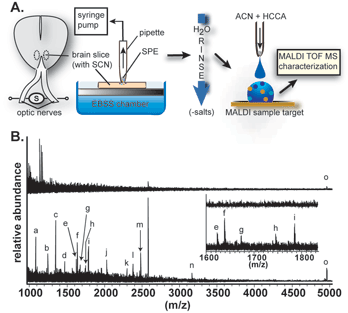Creating lists of peptides for a specific brain region is an important process. However, even more so is understanding which peptides are released from the region, thereby providing unique insights into those that are putative and biologically active. We are developing a range of sampling approaches to collect peptide release from spatially defined locations of living cells and tissues in an activity-dependent manner. In one approach, solid-phase extraction methods employing individual bead particles are used in ex vivo brain slices. The solid phase extraction material collects and concentrates peptide release, with the peptides then extracted and characterized using MALDI-MS; both pipette tips and individual beads sample extracellular regions directly from the surface of intact tissues. Another approach is well suited for working with freely behaving animals and involves the use of microdialysis to measure peptide release. In vivo sampling of brain releasates is accomplished with surgically implanted dialysis probes positioned stereotaxically to the brain region of interest. Using these techniques, the activity-dependent changes in the brain peptide complement have been measured, leading to the discovery of new brain peptides and new functional roles for known peptides. |
Characterization of RHT-stimulated SCN releasates. A. Sample collection and preparation. B. MS characterization of SCN releasates. (Inset: a zoomed mass range highlighting compounds not clearly observable in the expanded spectrum.) Labeled analytes are as follows: (a) AVP, (b) proSomatostatin 89-100, (c) substance P, (d) PENK 219-229, (e) melanotropin a, (f) somatostatin 14, (g) pyro-glu neurotensin, (h) big LEN, (i) little SAAS, (j) unknown 2028.02 m/z, (k) PEN, (l) unknown 2380.10 m/z, (m) unknowns 2481.26/2481.77 m/z, (n) galanin, and (o) thymosin β4. Adapted from Hatcher et al., Proc. Natl. Acad. Sci. U.S.A. 105, 2008, 12527-12532. |
Relevant Publications: |


